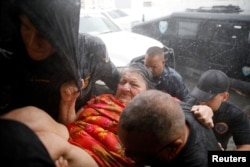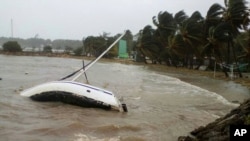The U.S. National Hurricane Center says Hurricane Maria continues to pound parts of Puerto Rico with strong winds and widespread flooding after making landfall Wednesday as a Category 4 storm.
Maria, one of the most powerful storms ever to hit Puerto Rico, was downgraded Wednesday to a category three hurricane with maximum sustained winds of about 185 kilometers per hour.
The storm is causing flash floods and landslides and has left at least nine people dead across the Caribbean. After Maria blew ashore Wednesday morning along the southeastern coast of Puerto Rico, widespread flooding ensued with reports of many streets being turned into rivers.
Those threats also continued in the U.S. and British Virgin Islands as the back side of the storm moved slowly after the outer eye wall hit St. Croix.
Forecasters expect the center of the hurricane to move offshore the northern coast of Puerto Rico and reach open water late Wednesday, bringing hurricane conditions to the Dominican Republic late Wednesday and Thursday.
Despite its downgrade, Maria will remain a "dangerous major hurricane" as it approaches the Turks and Caicos Islands and the southeastern Bahamas Thursday and Friday.
As the storm churned slowly across Puerto Rico, it tore roofs off homes, knocked down cell phone towers, snapped trees and unleashed heavy flooding as it dumped at least 50 centimeters (20 inches) of rain.
In Photos: Hurricane Maria Makes Landfall in Puerto Rico
Governor Ricardo Rossello, whose administration set up 500 shelters that are housing more than 11,000 people, urged people to have faith as they wait out the storm before beginning the process of damage assessment.
"We are stronger than any hurricane. Together, we will rebuild."
U.S. President Donald Trump has issued state-of-emergency declarations for Puerto Rico and the U.S. Virgin Islands, where St. Croix sustained heavy damage.
Guadeloupe, Dominica
Before arriving at the U.S. territories, Hurricane Maria went directly over the island of Dominica, while also nearly making landfall in Guadeloupe, where at least two people were killed.
Dominica Prime Minister Roosevelt Skerrit wrote on Facebook that initial reports indicate "widespread devastation." He added the focus is on finding injured or trapped people in rubble, hopefully with the help of international aid.
"We will need help, my friend, we will need help of all kinds," he said.
Maria is the second major hurricane to pound the Caribbean this month. Hurricane Irma, one of the most powerful Atlantic storms on record, killed 38 people in the Caribbean and another 36 in the United States, leaving a trail of widespread destruction on several Caribbean islands and the Florida Keys.
Maria, tied for eighth as the strongest hurricane in Atlantic history, is the most powerful storm to hit Puerto Rico in nearly 90 years.
The hurricane will likely have an adverse impact on the economy of Puerto Rico, which is struggling with the largest municipal debt crisis in U.S. history.







